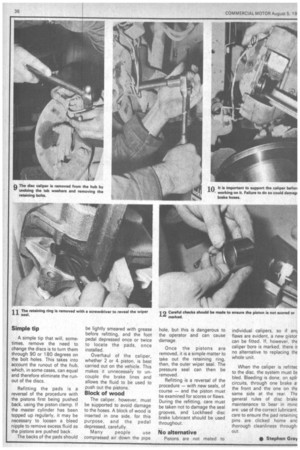Discs move up weight scale
Page 36

Page 37

Page 38

If you've noticed an error in this article please click here to report it so we can fix it.
FRONT-WHEEL disc brakes have been common on carderived light vans and pickups for some time, but it's only recently that they've been applied to larger vehicles with gross weights up to 3.56 tonnes (3.5 tons).
There are several reasons for this. More often than not, the cars used as the basis of the derived commercials are themselves fitted with front discs and it would be uneconomic to design different suspension to accept drum brakes.
Larger light commercials, on the other hand, tend to be designed on large vehicle principles with drum brakes all round.
But the need for brake performance to meet EEC brak
ing requirements and, simultaneously, to satisfy driver demand for car-like pedal efforts on vehicles up to 3.56 tonnes (3.5 tons), has resulted in Automotive Products Ltd producing a disc brake system. for vans and pick-ups in this range.
Easy to maintain
Part of the basic requirements for the system was that it should be easy to maintain, so I visited AP, at Leamington, to see just how easy maintenance is.
The company's disc brake system, designed to suit all vehicles in the sector, comprises three different set-ups.
The basic system uses two piston calipers in conjunction with solid discs up-front and self-adjusting drum brakes at the rear. For middle weight and higher performance vehicles four piston calipers with solid discs are used, while, for the top weight vehicles, four piston calipers with ventilated discs are employed.
Maintaining any of these systems is, basically, fairly easy, but a few simple rules need to be observed.
Damage warning
Changing the disc pads is probably the simplest of all the repairs on disc brakes. AP emphasises, however, that in no circumstances should the disc caliper be separated, because damage could occur to the bolt threads.
For a pad change, the only tools required are a pair of pliers, a spanner to loosen the bleed nipples and a Lockheed piston clamp (part number 4171-959) to draw back the pistons.
Having made sure that the vehicle is jacked up and supported at the front with the park brake on, the wheels are removed.
Next, the pad retaining springs are depressed so that the locating pins can be removed. These are notched to locate behind each side of thi spring.
Now, the pads can be taker out of the caliper recesses.
After the pads are removed all parts should be cleaned especially the friction pac recesses and exposed parts o. he pistons.
Important
There are two important requirements here: first. use only industrial methylated spirits or clean Lockheed brake fluid; second, the exposed piston parts must be thoroughly cleaned before they are pushed back.
Once these areas are clean, the piston surfaces and pad recesses should be greased using Lockheed disc brake lubricant. It is absolutely essential that no other lubricant is used because this could affect the rubber seals in the caliper cylinders.
The discs themselves must be inspected for scores, cracks, or distortion before new pads are inserted.
If there is any doubt, the. ,discs should be changed. Checking the run-out of the discs, which causes shudder when braking, can be achieved using a dial gauge.
Simple tip
A simple tip that will, sometimes, remove the need to change the discs is to turn them through 90 or 180 degrees on the bolt holes. This takes into account the runout of the hub, which, in some cases, can equal and therefore eliminate the runout of the discs.
Refitting the pads is a reversal of the procedure with the pistons first being pushed back, using the piston clamp. If the master cylinder has been topped up regularly, it may be necessary to loosen a bleed nipple to remove excess fluid as the pistons are pushed back.
The backs of the pads should be lightly smeared with grease before refitting, and the foot pedal depressed once or twice to locate the pads, once installed.
Overhaul of the caliper, whether 2 or 4 piston, is best carried out on the vehicle. This makes it unnecessary to uncouple the brake lines and allows the fluid to be used to push out the pistons.
Block of wood
The caliper, however, must be supported to avoid damage to the hoses. A block of wood is inserted in one side, for this purpose, and the pedal depressed, carefully.
Many people use compressed air down the pipe hole, but this is dangerous to the operator and can cause damage.
Once the pistons are removed, it is a simple matter to take out the retaining ring, then, the outer wiper seal. The pressure seal can then be removed.
Refitting is a reversal of the procedure — with new seals, of course — and the piston must be examined for scores or flaws. During the refitting, care must be taken not to damage the seal grooves, and Lockheed disc brake lubricant should be used throughout.
No alternative
Pistons are not mated to individual calipers, so if an flaws are evident, a new pistor can be fitted. If, however, thE caliper bore is marked, there iE no alternative to replacing thE whole unit.
When the caliper is refittec to the disc, the system must bE bled. Bleeding is done, on spli. circuits, through one brake a' the front and the one on thE same side at the rear. ThE general rules of disc brakE maintenance to bear in minc are: use of the correct lubricant, care to ensure the pad retaining pins are clicked home and thorough cleanliness throughout.
• Stephen Gray








































































































